When you start learning how to read drum notation, you’ll gain an essential skill for interpreting and playing music accurately. This begins with understanding the staff, which consists of five lines and four spaces where different drum parts are notated. Each line and space represents a specific drum or cymbal, and knowing this layout helps you decode the music swiftly. But it’s not just about recognizing where notes sit; you also need to grasp basic note values to understand rhythmic patterns. So, how do these elements come together to form a coherent piece? Let’s look closer at how each component plays a role.
TL-DR
- Drum notation uses a five-line staff where different drums and cymbals are placed on specific lines or spaces for accurate reading.
- Note values in drum notation indicate the duration of each beat, similar to traditional music notation.
- Time signatures define the rhythmic structure, showing how many beats per measure and the note value that gets the beat.
- Repeat signs and endings help navigate through repeated sections efficiently, ensuring smooth transitions and accurate performance.
- Practice reading and playing with a metronome to develop timing and familiarity with different rhythmic patterns and note values.
The Importance of Drum Notation
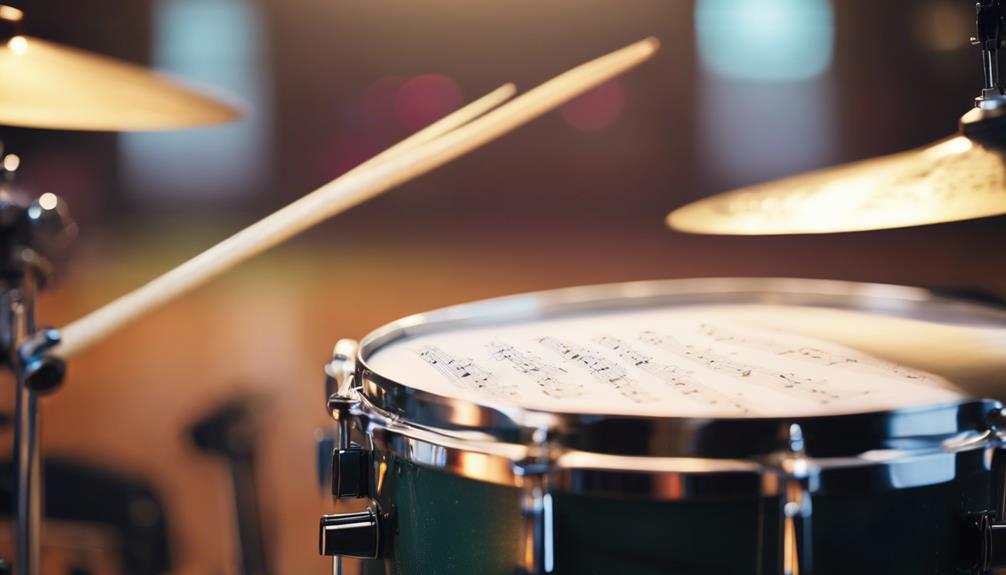
Drum notation’s significance can’t be overstated, as it enables drummers to effectively communicate and perform complex rhythms. When you learn to read drum music, you’re not just deciphering notes on a page; you’re decoding the language of drumming. This skill allows you to comprehend drum patterns, rhythms, and songs with precision. Drum notation, while different from standard sheet music, is actually easier to read and is tailored specifically for drummers.
Mastering this skill enhances your ability to practice consistently, which is essential for developing solid drum techniques. By understanding drum notation, you improve your coordination, timing, and rhythm. These are fundamental aspects of drumming that can elevate your performance from good to great.
One key element to help you on this journey is the drum key, a guide that explains the symbols used in drum notation. This tool is indispensable when you’re starting to learn to read drum music. By consistently using the drum key, you’ll quickly become proficient in interpreting the various notations.
Understanding the Staff
To read drum notation, you need to understand the staff’s lines and spaces, where each drum or cymbal’s note is placed.
You’ll also want to familiarize yourself with a note placement guide to quickly identify each sound’s position.
Lastly, knowing the basics of time signatures will help you keep the rhythm and timing in check.
Lines and Spaces
In drum notation, the staff comprises five horizontal lines where each drum part is written on a specific line or space for easy identification. Understanding these lines and spaces is essential for interpreting the notes played on different parts of the drum set.
For example, notes on a snare drum are usually found on the third space of the staff, while the bass drum often occupies the bottom line. Each drum and cymbal has its designated position, ensuring you can quickly locate and play the corresponding sounds.
When you see notes on a snare, it’s situated in the middle range of the staff, reflecting its pitch relative to other parts of the drum set. The floor tom and bass drum, being lower-pitched, are written towards the bottom, while higher-pitched cymbals are at the top.
This organization makes it easier to read and execute drum patterns accurately.
Note Placement Guide
Understanding where each drum and cymbal is placed on the staff is essential for reading drum notation accurately. The staff in drum notation consists of five horizontal lines. Each line and space represents a different drum or cymbal, and their placement helps you quickly identify which part of the drum set to play.
Start by noting that lower-pitched drums, like the bass drum, are typically positioned at the bottom of the staff. This makes it easy to recognize these fundamental beats as they anchor your rhythm.
Moving up, you’ll find that snare drums and toms occupy the middle of the staff. These mid-range notes are important for adding texture and variety to your drumming patterns.
At the top of the staff, you’ll see the higher-pitched cymbals, such as the hi-hats, crash, and ride cymbals. Their placement above the other notes makes them easily distinguishable, allowing you to incorporate them seamlessly into your playing.
Time Signature Basics
Time signatures are the key to understanding the rhythmic structure of any drum notation. They tell you how many beats per measure you’ll be playing and what note value gets the beat. For example, in a 4/4 time signature, there are four beats per measure, and the quarter note gets one beat. Understanding the time signature is essential for maintaining rhythm control and accuracy.
The staff in drum notation consists of five horizontal lines where drum notes are placed. Each line and space corresponds to a specific part of the drum set. Here’s what you need to know:
- Top Line: Usually represents the high-hat cymbal.
- Second Line: Often used for the snare drum.
- Third Line: Typically indicates the floor tom.
- Bottom Line: Represents the bass drum.
Understanding which drum notes align with which position on the staff helps you accurately play the intended rhythm. The combination of time signature and staff layout is fundamental for interpreting drum notation.
Mastering these basics will enhance your rhythm control and ensure you play with precision.
Time Signatures
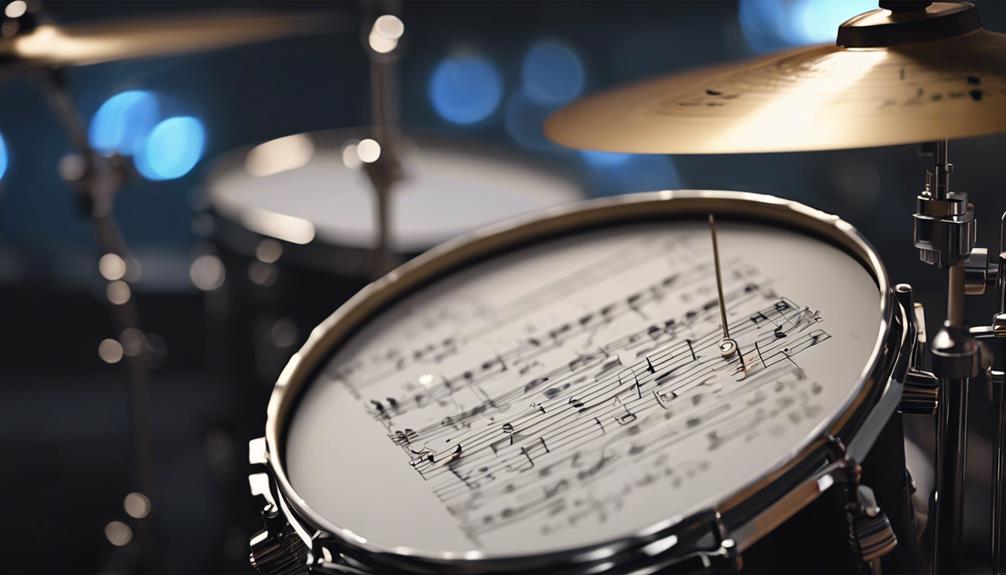
When you look at time signatures in drum notation, you’ll see how they set the framework for your beats and rhythms.
Understanding note values and counting beats accurately is essential for playing in time.
Let’s explore some common time signatures and how they influence your drumming patterns.
Understanding Note Values
Understanding the significance of note values and time signatures is essential for accurately interpreting drum notation. Note values indicate the duration of each note played in a piece, which is important for maintaining the intended rhythmic feel. In drum notation, you’ll encounter various note values such as whole notes, half notes, quarter notes, and eighth notes. Each of these represents a different length of time for which a note is held.
Time signatures, on the other hand, tell you how many beats are in each measure and which note value is equivalent to one beat. For instance, in a 4/4 time signature, there are four beats per measure, with the quarter note getting one beat. Mastery of both note values and time signatures allows you to interpret rhythms accurately and play with the correct timing and feel.
Here’s a quick breakdown:
- Whole Note: Takes up the entire measure in 4/4 time.
- Half Note: Occupies half the measure, spanning two beats.
- Quarter Note: Each beat gets one note.
- Eighth Note: Each beat is divided into two notes.
Different time signatures, like 3/4 or 6/8, will change the rhythmic feel and pattern of your drum beats, making the understanding of these elements essential for effective drumming.
Counting Beats Accurately
Mastering the skill of counting beats accurately guarantees you maintain a steady rhythm and timing while playing drums. To do this effectively, you need to understand time signatures, which indicate how many beats are in each measure. The top number tells you the beats per measure, while the bottom number shows the note value.
For example, in a 4/4 time signature, there are four beats per measure, with each beat being a quarter note. This is the most common time signature and is often used in various musical genres. When you’re counting beats in different time signatures, like 3/4 or 6/8, you need to adjust your count to match the specified number of beats per measure. This adjustment ensures that your rhythm and timing remain consistent, which is vital for a cohesive performance.
Additionally, practicing counting beats at different beats per minute (BPM) will improve your ability to maintain a steady tempo. This practice is important for enhancing your musical interpretation and expression.
Common Time Signatures
Knowing how to count beats accurately lays the groundwork for understanding common time signatures in drum notation. Time signatures tell you how many beats per measure there are and what note value represents one beat.
Let’s explore the most common ones you’ll encounter.
- 4/4 Time Signature: This is the most prevalent time signature in drum music. Here, you’ll find four beats per measure, with each quarter note receiving one beat. It’s straightforward and versatile, making it a staple in many musical genres.
- 3/4 Time Signature: Often found in waltz rhythms, 3/4 time has three beats per measure. Each quarter note still gets one beat, but the feel is more lilting and dance-like, perfect for slower, more rhythmic pieces.
- 6/8 Time Signature: This time signature has six beats per measure, with the eighth note getting one beat. It’s commonly used for compound rhythms, where you’ll see patterns like triplets, giving the music a flowing, rolling feel.
- Note Value: Understanding the note value associated with each time signature helps maintain rhythm and structure. For instance, in 4/4, the quarter note is important, while in 6/8, the eighth note takes prominence.
Mastering these time signatures is essential for any drummer aiming to read and play drum notation proficiently.
Basic Note Values
When reading drum notation, you need to recognize the basic note values to accurately play rhythms. Each drum note has a specific duration, and understanding these is vital for creating accurate drum patterns.
A whole note, for instance, typically represents four beats in a 4/4 time signature, meaning you’ll strike the drum and let it resonate for the entire measure. A half note is played for two beats, so you’d hit the drum and count to two before the next note.
Quarter notes are very common in drum music and represent one beat each. You’ll strike the drum on each beat, providing a steady rhythm. Eighth notes, on the other hand, are played for half a beat. This means you’ll be hitting the drum twice as often as with quarter notes, resulting in a quicker rhythm.
Finally, sixteenth notes are played for a quarter of a beat, introducing even more complexity and speed to your drumming.
Mastering these basic note values will give you a solid foundation, helping you interpret and perform drum notation accurately. As you practice, you’ll become more comfortable switching between these note values and achieving the desired rhythmic effect.
Notating Different Drums

When reading drum notation, you’ll notice different drums are notated in specific positions on the staff.
The bass drum is typically on the bottom line, the snare drum on the middle line, and tom-toms are placed in the spaces between.
Understanding these placements helps you accurately interpret and play the written music.
Bass Drum Notation
In drum notation, the bass drum is depicted by a solid round note on the bottom line of the staff, marking the beats you’ll play with your right foot. This fundamental aspect of drum notation is important as it helps you read and understand the rhythmic foundation of your drum set. By learning to read bass drum notation, you can establish a strong beat and maintain the tempo, which is essential for any musical piece.
To master bass drum notation, consider these key points:
- Foot Coordination: Since the bass drum is played with your right foot, developing control over your foot pedal is crucial. Practice consistently to build muscle memory.
- Rhythmic Foundation: The bass drum often marks the primary beats in a measure, providing the backbone of the rhythm. Pay close attention to its placement in the staff.
- Syncing with Other Drums: Coordinating the bass drum with your hands playing other parts of the set is important. This sync ensures a cohesive and smooth performance.
- Tempo Maintenance: The bass drum’s steady beat helps in maintaining the overall tempo, important for keeping the band or ensemble in sync.
Understanding and mastering bass drum notation will greatly enhance your overall drumming skills, laying a solid rhythmic foundation for more complex patterns.
Snare Drum Notation
After mastering the bass drum, you’ll find that reading snare drum notation is the next step in developing your drumming skills. Snare drum notation is typically represented by a solid round note placed on the middle line of the staff. This position guarantees that you can easily distinguish it from the higher-pitched cymbals and the lower-pitched toms.
In some cases, an ‘x’ symbol is used to indicate the snare drum, helping to differentiate it from other drums like the bass drum. When you read drum sheet music, recognizing this symbol is vital for playing the correct drum with the right technique.
Understanding snare drum notation is essential for drummers aiming to play intricate rhythms and patterns accurately. It allows you to develop the coordination and precision needed for various drumming styles, whether you’re playing rock, jazz, or marching band music.
As you practice reading snare drum notation, focus on the precision of your strokes and the consistency of your timing. The snare drum often plays a central role in many rhythms, so mastering its notation will greatly enhance your overall drumming abilities.
With time and practice, you’ll find that reading and playing snare drum parts becomes second nature.
Tom-Tom Notation
You’ll find that tom-tom notation involves assigning each drum a specific line or space on the staff to indicate its pitch. This system allows you to differentiate between the high tom, mid tom, and floor tom. The tom-toms are typically represented from highest to lowest pitch, with the higher toms placed higher on the drum staff and the lower toms placed lower.
In tom-tom notation, round note symbols are used, similar to those for the snare drum. However, their positions on the staff vary to reflect the different pitches of the toms. This makes it clear which drum to hit, ensuring accurate drumming patterns and fills.
Here’s how you can read tom-tom notation:
- High Tom: Usually placed on the top line or the first space above the drum staff.
- Mid Tom: Positioned on the middle line or the space above it.
- Floor Tom: Found on the bottom line or the space below the middle line.
- Understanding Pitch: Higher toms are notated higher on the staff, while lower toms are notated lower.
Cymbal Notation
Cymbal notation, marked by ‘x’ symbols, is essential for drummers to accurately interpret and play different cymbal sounds like the hi-hat, crash, and ride. When you see an ‘x’ on the staff, it typically indicates a cymbal hit. Each type of cymbal has a specific place on the staff: the hi-hat is usually placed above the top line, the crash cymbal is placed slightly lower, and the ride cymbal is often on the same line or just above the hi-hat.
Understanding cymbal notation helps you play with precision and expression. For instance, a closed hi-hat is shown with an ‘x’ on the top space, often with a line through it, while an open hi-hat might’ve an ‘o’ above it. Crash cymbals usually get a prominent ‘x’ on a higher line, indicating its explosive sound. The ride cymbal, essential for keeping time, is often marked with an ‘x’ on the middle line or slightly above.
Accents and Dynamics

Building on your understanding of cymbal notation, accents and dynamics in drum notation are key for bringing out the expressive qualities of your drumming. Accents are special markings that tell you to emphasize specific notes. You’ll often see an accent symbol like ‘>’ above or below a note. This means you should hit that note with more intensity.
Dynamics refer to the overall volume and intensity of your playing. In drum notation, dynamics are indicated by symbols such as ‘f’ for loud (forte) and ‘p’ for soft (piano). Mastering these elements allows you to add musical expression and feeling to your performances.
Here’s how you can incorporate accents and dynamics:
- Identify Accent Symbols: Look for ‘>’ to know which notes need extra emphasis.
- Understand Dynamics Markings: Know that ‘f’ means loud and ‘p’ means soft.
- Practice Volume Control: Adjust your striking force to match the dynamics indicated.
- Combine Accents and Dynamics: Use both to create a dynamic and expressive performance.
Reading Repeat Signs
When reading drum notation, you’ll encounter repeat signs that indicate when to replay sections of the music. Recognizing these signs is key. Knowing how to use first and second endings is crucial. Handling multiple repeats are also important skills for maintaining the song’s structure.
Mastering these elements guarantees you stay on track and play the correct patterns consistently.
Identifying Repeat Signs
Reading repeat signs in drum notation is crucial for guaranteeing you play music with consistency and precision. Repeat signs help you identify sections of music that need to be played again, maintaining the structure and flow of a piece.
In drum notation, you’ll encounter various types of repeat signs, each with its specific meaning.
- Repeat Sign: The standard repeat sign consists of two dots placed before a double barline. When you see this, it means you should go back to the previous repeat sign or the beginning of the piece if none exists.
- One-Bar Repeat Sign: This sign looks like a single slash with two dots and indicates that you should repeat the previous measure. It’s especially useful for maintaining consistency in repetitive drum patterns.
- Two-Bar Repeat Sign: Similar to the one-bar repeat sign, but with two slashes and dots. It means you need to repeat the previous two measures, helping to reinforce longer repetitive sequences.
- Multiple Measure Repeats: Sometimes, you’ll see slashes with numbers above them, indicating the number of measures to repeat. This keeps the structure intact without cluttering the notation.
Mastering these repeat signs ensures your drumming is precise and consistent, enhancing your overall performance.
Using First and Second Endings
First and second endings in drum notation guide you through repeated sections by indicating where to repeat from and how to conclude the passage differently on subsequent runs. When you encounter first endings, you’ll play through the specific section and then follow the repeat signs to navigate back to the beginning of the repeated section. This guarantees you play the section more than once as intended.
On the first pass, you play the first ending, which typically leads directly to the repeat signs. When you reach the repeat signs, go back and play from the specified section again.
On your second run through, instead of playing the first ending again, you’ll skip it and proceed to the second ending. This second ending offers an alternative conclusion to the repeated sections, allowing for variety and a smooth progression to the next part of the music.
Understanding how to use first and second endings helps you navigate repeated sections accurately and ensures you follow the composer’s intentions. By mastering this, you’ll add depth and professionalism to your drumming, making your performance more dynamic and engaging.
Navigating Multiple Repeats
Repeat signs in drum notation simplify the process of moving through specific sections, ensuring you play them accurately and consistently. They help you maintain the song’s structure by indicating when to repeat a measure or a series of measures. Mastering these signs is essential for any drummer who wants to read notation fluently.
When exploring multiple repeats, you’ll encounter several types of repeat signs:
- One-bar repeat: This sign looks like a percent symbol (%) and tells you to repeat the previous measure. It’s a quick way to save space and keep your notation clean.
- Two-bar repeat: Represented by double percent symbols (%%), this sign instructs you to repeat the last two measures. It’s important for maintaining consistency when patterns span multiple bars.
- Standard repeat signs: These include the double bar lines with two dots. They mark the beginning and end of a section to be repeated.
- First and second endings: Used in conjunction with repeat signs, these indicate different endings for the repeated section, adding variation and complexity to the structure.
Drum Clef Explained
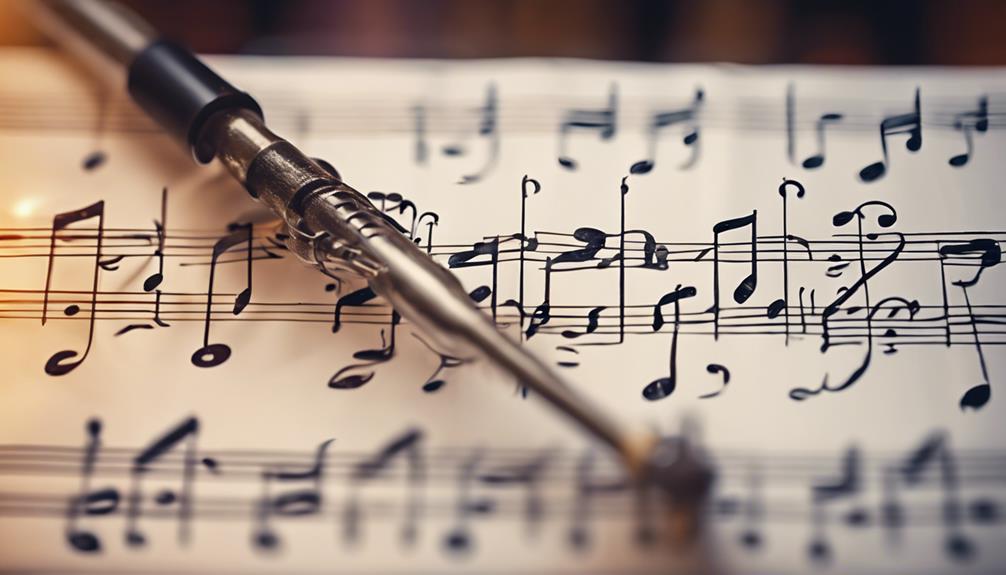
When you see the drum clef at the beginning of a piece, it signifies that the music is specifically written for percussion instruments. The drum clef consists of two vertical lines with two dots that frame the staff. This symbol is essential to drum notation and helps you understand that the music is tailored for drummers.
The drum clef’s placement on the staff is vital for identifying which drum parts to play. Unlike traditional sheet music that uses treble or bass clefs, drum notation relies on the drum clef to indicate percussion instruments. Each line and space on the staff corresponds to a different drum or cymbal, so knowing the staff placement of the drum clef is necessary for accurate interpretation.
Reading drum notation can initially seem challenging, but the drum clef simplifies the process. By framing the staff, it guides you in interpreting the notation correctly. Understanding the drum clef ensures that you can read and play the written parts accurately, making your drumming more precise and effective.
Measures and Bar Lines
Now that you’re familiar with the drum clef, let’s look at how measures and bar lines structure the rhythm in drum notation.
Measures are segments of music separated by bar lines, and each measure contains a specific number of beats determined by the time signature. Bar lines divide the music into equal sections, which helps in organizing and structuring the rhythm for easier reading and interpretation.
Understanding measures and bar lines is essential for maintaining rhythm and timing.
Here’s how they function:
- Measures: These are the building blocks of a piece of music, each containing a set number of beats.
- Bar Lines: These vertical lines separate each measure, making the music visually easier to follow.
- Time Signature: This notation at the beginning of a piece indicates how many beats are in each measure and what note value constitutes one beat.
- Organizing Rhythm: Bar lines and measures help you keep track of where you’re in the music, ensuring you maintain the correct rhythm and timing.
Tempo Markings
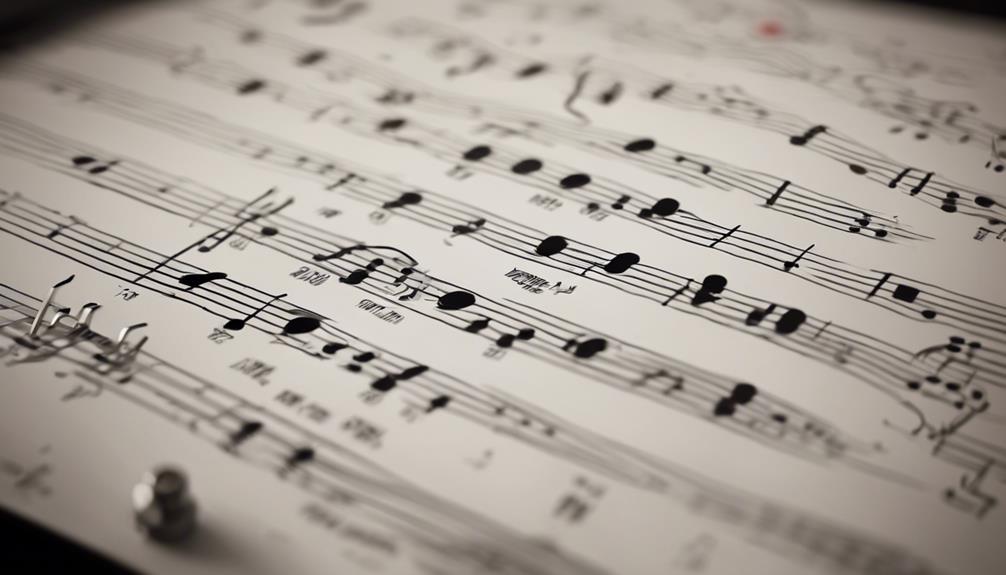
Understanding tempo markings in drum notation is essential for playing a piece at the correct speed and conveying its intended mood. Tempo markings tell you how fast or slow to play, usually measured in Beats Per Minute (BPM).
For example, Allegro indicates a fast tempo, while Moderato suggests a moderate pace. Knowing these terms helps you match the intended energy of the piece, whether it’s lively or more laid-back.
When you see a tempo marking like Andante or Adagio, it guides you to play at a walking pace or a slow tempo, respectively. These markings are vital for maintaining consistent timing and rhythm. They ensure that you and any other musicians stay in sync and deliver the piece as the composer intended.
Using metronomes can be incredibly helpful for keeping on tempo. A metronome provides a steady beat, making it easier to practice and develop a strong sense of timing.
Sticking Techniques
Mastering sticking techniques is essential for any drummer looking to enhance their speed, control, and overall efficiency. Proper sticking techniques allow you to execute drum notation with precision and fluidity.
Whether you’re using a matched grip, traditional grip, or another method, each technique has its own set of advantages and is suited for different drumming styles.
Here’s a breakdown of some key sticking techniques:
- Matched Grip: This is the most common grip where both hands hold the sticks identically. It offers great control and power, making it ideal for rock and pop drumming.
- Traditional Grip: Favored by jazz and marching drummers, this grip has one stick held differently, providing a unique angle and touch. It’s particularly useful for intricate and subtle playing.
- French Grip: In this grip, the thumbs are positioned on top of the sticks, allowing for finer control and speed, especially in the context of cymbal work.
- German Grip: Similar to the matched grip but with palms facing down, this grip gives you powerful strokes and is perfect for heavy hitting.
Phrasing and Accents
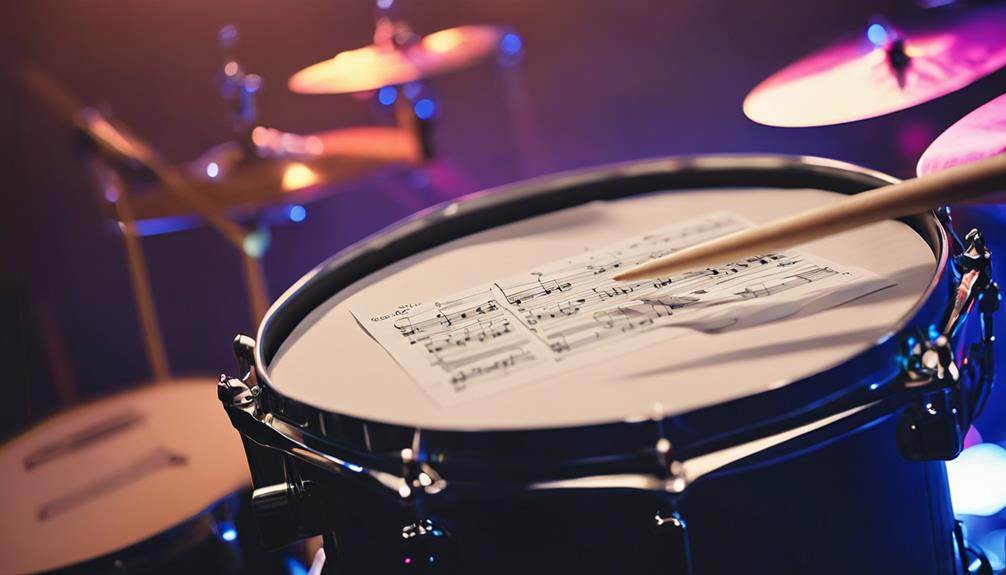
Phrasing and accents in drum notation help you bring musicality and expression to your drumming. Phrasing involves grouping notes in a way that creates coherent musical patterns. By organizing your notes into phrases, you can transform a series of beats into a compelling rhythm. Think of phrasing as creating sentences with your drumming, where each note contributes to the overall story.
Accents play an essential role in adding dynamics to your drumming. By emphasizing certain notes, you introduce variations in loudness, which makes your performance more engaging. Accents are typically marked with symbols like > or ^ above the note. These symbols indicate that you should play that note louder than the surrounding notes.
Grouping notes and emphasizing specific beats through accents helps you create dynamic and expressive drumming patterns. This not only enhances the musicality of your performance but also allows you to convey different emotions and energies.
Understanding how to use phrasing and accents effectively will make your drumming more nuanced and impactful. So, pay attention to these elements in your drum notation to elevate your musical expression and overall performance.
Practice Strategies
To improve your drumming skills, break down complex drum patterns into smaller, manageable sections for focused practice. This approach lets you concentrate on specific parts of the music, making learning to read drum notation easier and less overwhelming.
Here are some effective practice strategies to help you refine your drumming:
- Use a Metronome: Keeping a consistent tempo is essential. Start slow and gradually increase the speed as you become more comfortable with the pattern. This builds your technical proficiency and guarantees you can play accurately at different tempos.
- Practice Routine: Establish a regular practice routine. Consistency is key to improvement. Dedicate time each day to work on different aspects of your drumming, from reading notation to playing various rhythms.
- Vary Dynamics: Practice playing sections with different dynamics. Switch between soft and loud to develop control over your drumming expression. This enhances your ability to convey emotion and adds depth to your performance.
- Record Sessions: Record your practice sessions to track your progress. Listen to the recordings to identify areas needing improvement. This feedback allows you to make necessary adjustments to your practice routine.
Advanced Notation Techniques
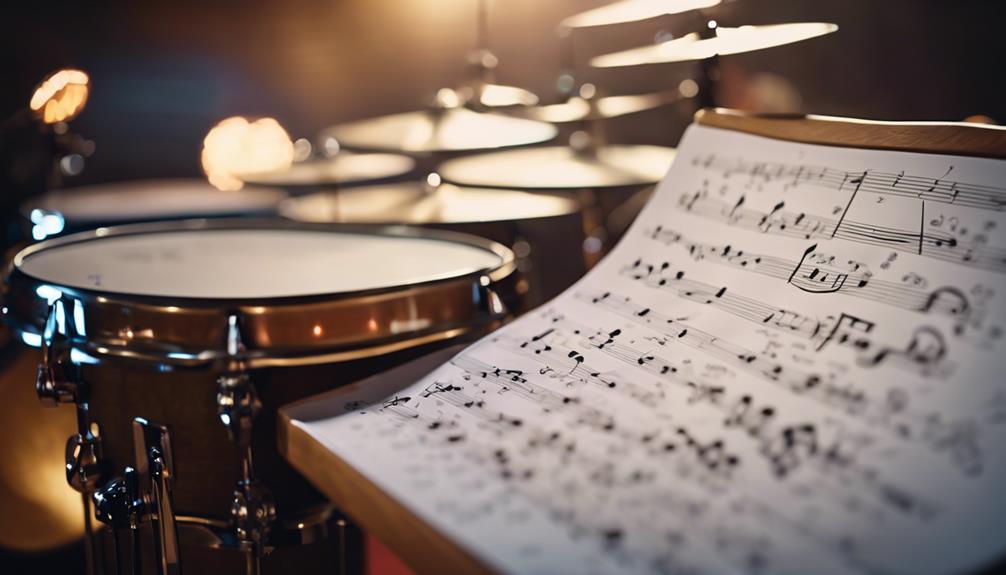
Diving into advanced notation techniques will elevate your drumming by introducing you to diverse musical expressions and enhancing your technical skills. Mastering alternative drum and cymbal notation lets you understand various playing techniques, bringing more control and flair to your performances.
Accents like drag, flam, ghost notes, and marcato add dynamics and nuances, enriching your music with intricate details. Understanding general music notation is important for interpreting symbols, marks, and instructions accurately on the music staff. Familiarize yourself with the drum notation clef, a symbol designed specifically for drummers to read and interpret musical scores. This specialized clef ensures you can follow the sheet music correctly.
Grasping the concepts of measures, bar lines, and time signatures is essential. Measures help organize your music, while bar lines separate these measures, making the notation easier to read. Time signatures indicate how many beats per measure and which note value gets the beat, maintaining proper timing in your drumming.
Next up, learn all about basic drum beats for beginners in this guide.
